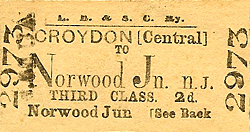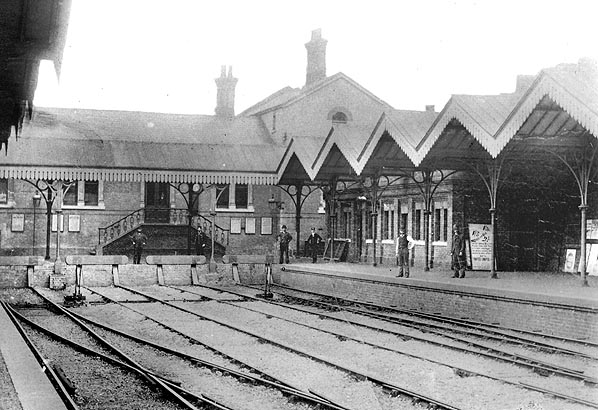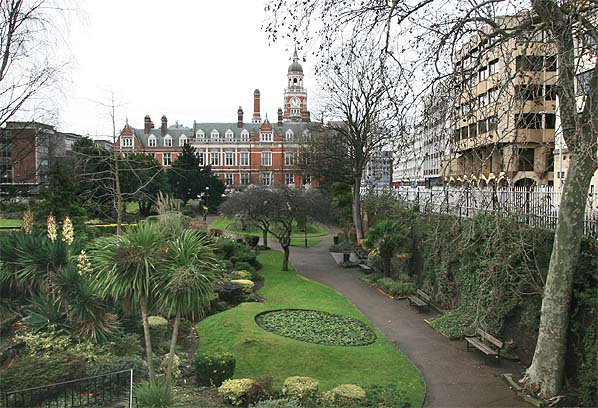|
Notes: The London & Croydon Railway was opened on 5th June 1839 from the London & Greenwich Railway's terminus at London Bridge to a terminus at Croydon (West Croydon from 1851) adjacent to the terminus of the Surrey Iron Railway which had opened in 1803, for much of its course the new line followed the bed of the disused Croydon Canal. The London & Brighton Railway opened their line to Brighton in 1841 using the London & Croydon line from London Bridge leaving it at Brighton Junction south of Jolly Sailor Station (Norwood) and running on through a new station at Croydon which opened on 12th July 1841 (East Croydon from 1850) finally reaching Brighton on 21st September 1841. On 27th July 1846 the London & Croydon Railway and the London and Brighton Railway merged to form the London Brighton & South Coast Railway.
 |
On the 1st October 1860 the LBSCR reached the west end of London when they opened their station at Victoria. The new station was opened by a separate company, the Victoria Station and Pimlico Railway and was used by both the LBSCR and the London Chatham & Dover Railway who were granted running powers over it by the LBSCR. The line from Victoria |
joined the Brighton line at Windmill Junction north of East Croydon Station.
With the opening of the Victoria line, additional platforms were provided at East Croydon, these were treated as a separate station and given the name New Croydon. In 1864 the LBSCR received powers for a short branch from a junction just south of New Croydon into the centre of Croydon as East Croydon was deemed to far away from the busy town centre. The 29 chain branch from New Croydon to Croydon Central opened on 1st January 1868. The new station had two parallel platforms on the south side of Katherine Street protected by sawtooth canopies and two centre roads which could be used for storage or engine release. Behind the buffers there was a narrow concourse connected to the main building by two short flights of steps. The main station building was at right angles to Katherine Street and included a two storey stationmaster's house at the north end. There was a small cab yard to the side of the building. Beyond the platform the four tracks converged into two, flanked on the north side by a retaining wall below Katherine Street.
From the opening there were 12 daily trains from London Bridge and 13 up trains most calling at all stations. Another four down and three up trains ran between Central Croydon and Kensington (Addison Road). Despite its convenient siting for the town centre, it was quicker to change at New Croydon for a fast train into London and passengers made little use of the new station so by the beginning of 1871 the service was reduced to three trains each way to London Bridge and one afternoon journey down from Victoria. Complete closure followed after the last train on 30th November.
St. Paul Station (now Blackfriars) just north of the Thames opened on 10th May 1886 on the LCDR's City line providing another London terminus which could be reach from Croydon and Central Croydon was reopened on 1st June with the support of the Town Council. The LB & SC had little interest in the station however and it was only served by other companies trains. In its second period the station was often known as Croydon Central but this name was never shown in timetables. Initially there were only five LNWR trains a day from Willesden Junction Low Level via Crystal Palace and Kensington. Seven further daily trains were added from 1st February 1887 when the GER Liverpool Street - New Cross workings via the East London Railway were extended on weekdays. The station still failed to attract sufficient passengers and closed for the last time on 1st September 1890 when LNWR and GER trains were cut back to New Croydon. The tracks to the east of Park Lane were retained and converted into an engineer's department depot known as Fairfield Yard. The remainder of the branch was sold to Croydon Corporation and used for the new Town Hall which opened in 1896. Fairfield yard remained in use until February 1933 after which date the site was used as a temporary car park before cleared in the 1960's during the re-development of Croydon.
The Park Lane bridge was filled in about 1931
Today, Croydon Town Hall stands on the site of Central Croydon station but the cutting to the east of the town hall with its high brick retaining wall on the south side of Katherine Street survives as a sunken garden, part of the Queens Gardens. A pedestrian subway follows the course of the line under Park Lane and through the underground car park between the Ashcroft Theatre and the College of Art. A plaque commemorating Central Croydon Station can be seen on the retaining wall in Queens Gardens.
Source: Croydon's Railways by MWG Skinner - Kingfisher Railway Publications 1985
ISBN 0 946184 14 3. & London's Local Railways by Alan A Jackson - David & Charles 1978 ISBN 0 7153 7479 6. Ticket from Michael Stewart |

old4.jpg)

2.gif) This 1868 map show as the station as Katherine Street Station
This 1868 map show as the station as Katherine Street Station
aerial3.jpg)
 Home Page
Home Page 



aerial_thumb1.jpg)
aerial_thumb2.jpg)
thumb 5.jpg)



thumb3.gif)
